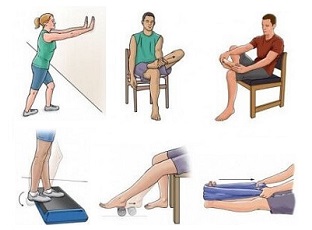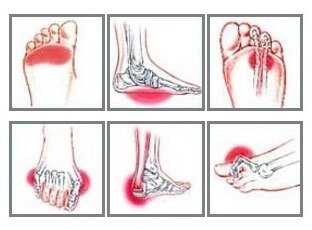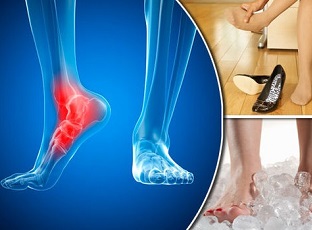- Home
- Foot Symptoms
- Swollen Feet and Ankles
- Treatment
Swollen Foot Treatment
Written By: Chloe Wilson BSc(Hons) Physiotherapy
Reviewed By: FPE Medical Review Board
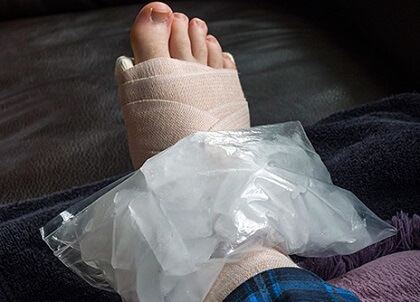
Suffering from a swollen foot? You are not alone. Most people will experience some type of foot and ankle swelling at some point in their life.
Foot swelling can be caused by a number of things such as an injury, high blood pressure, pregnancy and various medical conditions.
Swelling can come on gradually for no obvious reason or may develop suddenly following an injury. There may only be a small area of localized swelling or it may be profuse. It may only affect one foot, or both.
10 Ways To Treat A Swollen Foot
So let's look at some of the best ways to treat a swollen foot and ankle. If you have not already done so, we suggest you also visit the Common Causes of Swollen Feet section to find out about the ten most common causes of swelling in the foot.
1. Elevation
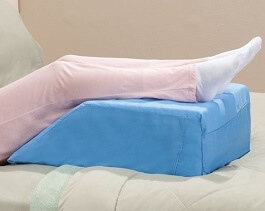
One of the best ways to start treating a swollen foot is to elevate it. This doesn’t mean just sitting with it resting up on something.
Ideally, you want the swollen ankle to be elevated above the height of your heart. This allows gravity to draw the swelling down and allow it to get back into circulation rather than pooling in your feet.
Aim to spend twenty minutes with your leg elevated at regular intervals during the day. At night time, prop your foot up on pillows so it remains elevated while you sleep. Do make sure your knee is supported too else you’ll wake up with a very stiff and sore knee.
2. Compression Bandage
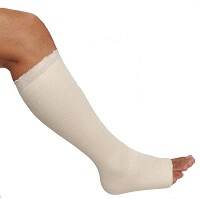
Wearing a tubular compression bandage such as tubigrip is a great way to reduce swelling. Tubigrip is a specially designed bandage that is tubular in shape that sits around your foot and calf. It is made up of tiny elastic threads covered in a soft fabric which exert pressure evenly over the area.
Tubigrip works most effectively when it is worn double thickness (i.e. two layers) and is extremely comfortable to wear providing just the right amount of compression to reduce swelling without feeling tight or restrictive.
Tubigrip compression bandages can be worn all day but should always be removed at night – you should never sleep in tubigrip. Tubigrip comes in a range of sizes, lengths and colors.
Visit the Tubigrip Compression Bandage section on our sister site to find out more about how it works, how to use it effectively and what size is right for you.
3. Exercise
Regular exercise, such as running or cycling, is another simple treatment tool and prevention measure for a swollen foot. Exercise improves circulation which can help to reduce foot swelling by helping to pump fluid back up into the blood stream to the heart.
You can also do simple exercises at home to get the foot and ankle moving to help reduce the swelling - visit the foot exercises section to find out more.
4. Less Salt, More Water

High sodium (salt) levels are a common cause of a swollen foot. Following a low salt diet can help reduce water retention that often results in swollen feet. Avoid processed foods which are often high in sodium and don’t put extra salt on your food.
Drinking more water helps to dilute the sodium levels and flush the salt out of your system. You should be aiming to drink at least 6-8 glasses of water per day.
Avoid drinks containing caffeine as they often contain sodium which further increases water retention.
5. Keep Moving
If you've got a swollen foot it is really important to keep moving. If the foot stays still, swelling pools around the foot and ankles making them puff up more as the day goes by. Foot swelling often builds up over night resulting in morning foot pain. Any time you are sitting or lying down for any length of time, pump your feet up and down, draw circles with your feet and lift the heel up and down to get the excess fluid pumping back up the leg into circulation again.
Try and get up regularly and walk around. Or if you are required to spend long periods on your feet, try to sit down when possible and elevate your feet.
6. Ice Therapy
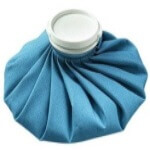
Ice is a great treatment tool for a swollen foot. Applying ice can help to reduce swelling especially if the swelling is a result of an injury. Ice helps to reduce the amount of localized bleeding which in turn reduces swelling. Ice packs should be used for ten minutes at a time every couple of hours.
There are a number of different ways to apply ice to a swollen foot from frozen veg to specially designed ice packs. Ice should never be placed directly on the skin else it can cause an ice burn. Visit the Ice Therapy section to find out more about how to safely and effectively use ice.
7. Massage

Massage helps to increase circulation and can be used to gently push fluid away from swollen feet. Get someone to help so you can relax during your massage.
Prop your feet up with pillows so that gravity can help out. Start at the toes and gradually work up to the lymphatic drainage points behind your knee in fluid, stroking movements to push the fluid up and away.
8. Diuretics aka Water Tablets
Diuretics are a type of medicine that reduce fluid build-up by increasing urine production. They are most commonly used when a swollen foot is caused by heart failure. They are not appropriate for every case of swelling so do discuss them with your doctor before taking them.
9. Avoid Tight Clothing & Shoes
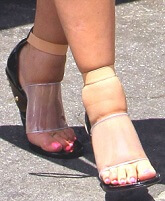
Avoid wearing clothes that are tight especially around the thighs to allow circulation to flow freely in the legs. Also avoid wearing shoes that are too tight as they can restrict blood flow.
A good tip is to go shoe shopping at the end of the day as our feet often swell slightly as the days goes by. Choose shoes with laces or Velcro so that they can be made looser or tighter as foot swelling fluctuates.
10. Weight Loss
Losing excess weight reduces the force and pressure going through your feet and can help to relieve the symptoms of a swollen foot. This is only appropriate if you are over-weight. Always discuss weight loss programmes with your doctor.
Safety Advice
Most of the time, a swollen foot is nothing to worry about. Occasionally, swelling can be a sign or a serious problem such as an injury or underlying medical condition. All new cases of foot swelling should be assessed by your doctor to ensure there is nothing sinister going on.
There are a few occasions when it can be a medical emergency. If you have sudden, profuse swelling, redness, warmth, pain, shortness of breath or a temperature, see you doctor immediately.
Also, if your swollen foot fails to improve after a few days, get it checked out.
What Else Can Help?
In order to choose the best treatment for you, it is important to know what is causing your swollen foot. Most times, the swelling is merely a symptom of an underlying problem so it is important to work out what is going on.
Visit the Common Causes of Foot Swelling section to find out more about the ten most common causes of swelling and the different types to help you work out the root cause of your swollen foot.
For other ideas on treating foot pain and swelling, visit the Foot Pain Treatment section.
You may also be interested in the following articles:
Related Articles
- Home
- Treatment Guide
- Treatment
Page Last Updated: 05/16/23
Next Review Due: 05/16/25
